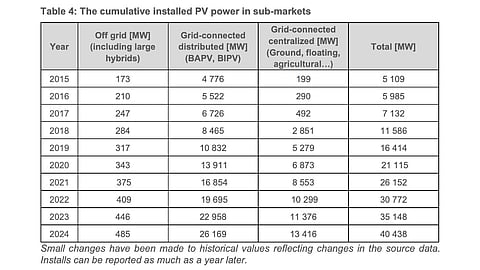

Solar PV systems now exceed 4 million installations in Australia representing over 40 GW combined capacity, supplying over 20% electricity, according to the IEA PVPS report
Average PV system sizes keep growing for rooftop solar, while commercial and large-scale segments strengthen under the 40 GW CIS program
Authors stress that the rapid solar growth is straining grid integration, pushing the need for storage, demand shifting, and updated market and tariff reforms
Australia, one of the world’s largest rooftop solar markets, grew by 5.3 GW of new solar PV capacity in 2024, expanding the country’s total installed capacity to over 40 GW with more than 4 million systems installed, says the International Energy Agency (IEA) in a new report.
In its National Survey Report of PV Power Applications in Australia 2024, the IEA Photovoltaic Power System Programme (IEA PVPS) provides a split of the country’s total installed PV capacity. It comprises 26.1 GW of distributed (grid-connected BAPV and BIPV facilities) and 13.4 GW of centralized installations, along with 485 MW of off-grid PV. This helps the country meet over 20% of its electricity demands from solar.
More than 44% of Australia’s free-standing households are now powered with a solar system, with the number of such homes averaging close to 50% in Queensland and South Australia. Thanks to the widespread adoption of rooftop solar, Australia is among the top 10 global markets for total installed capacity, with solar per capita at over 1.5 kW/person.
The market is also maturing steadily as the average PV system size has grown from less than 3 kW in 2012 to now close to 10 kW, and is even growing to 15 kW. Commercial systems range from 15 kW to 100 kW.
Even the large-scale utility solar segment has been expanding of late, driven by industrial and export considerations. Under the Capacity Investment Scheme (CIS), Australia plans to add another 40 GW capacity, divided as up to 26 GW of renewable energy generation and up to 14 GW of clean, dispatchable capacity (see Australia Expands Capacity Investment Scheme Target To 40 GW).
Thanks to this federal scheme supported by state-based initiatives, there is a firm pipeline of utility-scale projects in the country. The report reads, “Policy settings are designed to increase consumer and investor confidence and growth in the solar PV sector. Several large prospective projects, aimed at supporting energy exports and green-minerals processing, could significantly boost the market, with each project potentially adding 4 GW per year if implemented.”
Despite this growth, Australia’s solar PV sector continues to face challenges related to connection approvals, congestion management, and fragmented access arrangements that increase costs and risks for grid-scale projects, according to the IEA PVPS analysts.
Increasing investment in solar is making midday power cheaper and less valuable, pushing the need for storage and demand shifting. Growing renewables will require new policies, better tariffs, and greater investment in storage and the grid, recommend the authors of the report.
For rooftop solar, challenges include system size limits, rising network charges, and rules that still prioritize big power plants over distributed PV.
“Technology is moving faster than policy and regulation and, to maintain the rapid pace of renewable energy deployment, Australia needs to support national electricity market reforms and provide policy certainty to support the needed electricity infrastructure investments and additional electricity transmission, energy storage and demand response mechanisms,” add the report writers.
The complete report, prepared by the Australian PV Institute (APVI) and its members, is available for free download on the IEA PVPS website.
